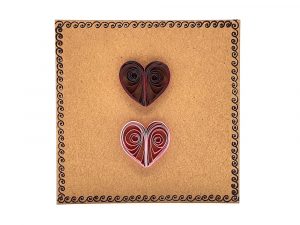The History of Valentine’s Day Cards – February 14th has become one of the key dates on the commercial calendar, it is estimated that £1.5 billion is spent on cards and gifts in the UK! However, the day we know today as Valentine’s Day has a fascinating history behind it, tracing all back to Ancient Rome.
Many believe that Valentine’s Day originated when the Ancient Romans celebrated the feast of Lupercalia, this was a fertility festival where men sacrificed goats before using their skins to whip women in the belief that this would make them more fertile. The young women would place their names in a big urn where the city’s bachelors would each choose a name and become paired for the year with their chosen woman. These matches would often end in marriage.
Towards the end of the 5th century, an attempt to reclaim this festival from the Romans was made by Pope Gelasius I who declared February 14th to be Valentine’s Day in order to Christianise it. It was not until much later, however, that the day became associated with love.
During the Middle Ages, the people of France and England believed that February 14th was the beginning of the birds’ mating season which added to the idea that Valentine’s Day should be a day for romance.
In 1375, the English poet Geoffrey Chaucer wrote a poem called “Parliament of Foules”, writing “For this was sent on Seynt Valentyne’s day / When every foul cometh there to choose his mate.” This is said to be the first record of portraying St. Valentine’s Day as a romantic celebration.
In 15th-century France, February 14th became an annual feast day celebrating romantic love. To mark the occasion, lavish banquets with singing and dancing were held. The oldest known valentine’s greeting was a poem written by a Frenchman named Charles, Duke of Orleans in 1415. He wrote to his wife while he was imprisoned in the Tower of London following his capture at the Battle of Agincourt.

The first Valentine’s cards were initially handmade and sent in the 18th century. People would decorate the paper with romantic symbols such as flowers and love knots, these handmade cards would often include puzzles and lines of poetry. Those who were less inspired, they could buy volumes that offered guidance on selecting the appropriate words and images to woo their lover. These cards were then slipped secretly under a door or tied to a doorknocker.
Pre-printed cards first began to appear in Georgian Britain; however, these were not yet as popular as they were eventually to become. Catherine Mossday sent perhaps one of the oldest surviving examples of one of these cards in 1797 to a Mr. Brown of London. It was decorated with flowers and images of Cupid with a verse printed around the border.
The industrialisation of Britain in the early 19th century brought with it rapid advances in printing and manufacturing technologies which allowed the mass-producing of Valentine’s cards to be easier than ever making it incredibly popular. By the mid-1820s, it is estimated that 200,000 Valentines’ cards were circulated in London alone. The introduction of the Uniform Penny Post (the UK’s official postal service before the Royal Mail) in 1840 increased the popularity of Valentine’s cards even further. By the late 1840s, the number of cards being circulated doubled and doubled once again in the next two decades!
Victorian Valentine’s cards tended to feature elaborate paper lacework, embossing, and other intricate designs. The stationer, Jonathan King ran a card-making enterprise in London. His collection demonstrated more than 1,700 examples of designs, verses, and sentiments that were popular with lovers in Victorian Britain. Jonathan King made the most elaborate card for the woman he loved. The card consisted of layer after layer of lace, decorated with embroidery, beads, ribbons, and shells. It included many lines of poetry, and even a secret concealed card featuring a paper chest of drawers. Each drawer lists a womanly virtue, but in the final drawer was a gold ring that he used to propose to his future wife. The romantic couple went on to marry and have 15 children, one of whom was appropriately named Valentine.
Valentine’s cards rapidly gained popularity in America, where they were initially advertised as British fashion. The advancement of American technology meant that the more elaborate cards could be produced cheaply, encouraging their popularity yet further. In 1913 Hallmark Cards produced their first Valentine’s card, representing a key development in the commercialisation of Valentine’s Day.
Today, people show their affection by not only sending cards but also buying flowers, jewellery, perfume, and chocolates. According to the Greeting Card Association, Valentine’s Day is the second most popular holiday for sending greeting cards. From 14th-century poetry to modern digitalised e-cards, Valentine’s cards have seen many versions, but the sentiment remains the same.
Millennium Milli


